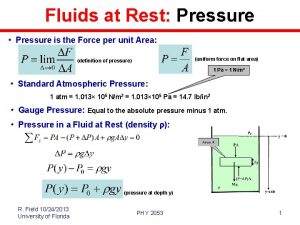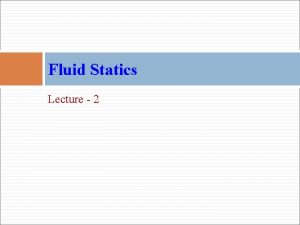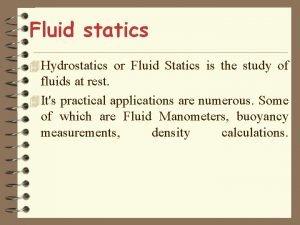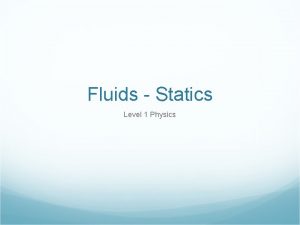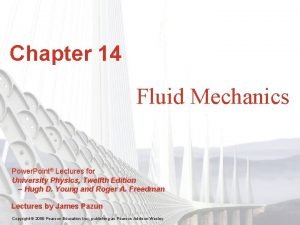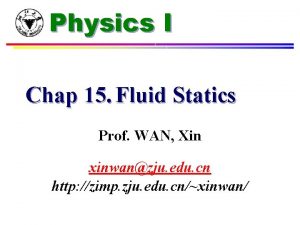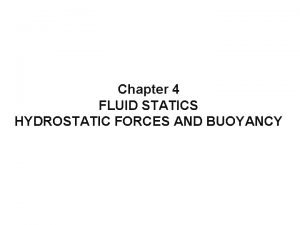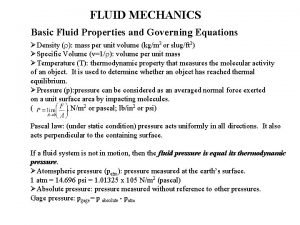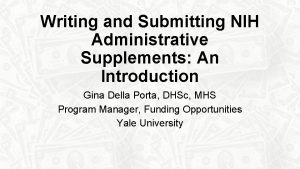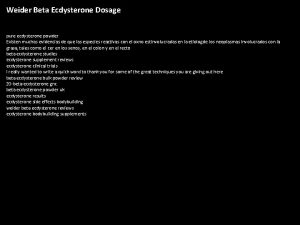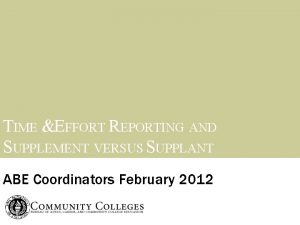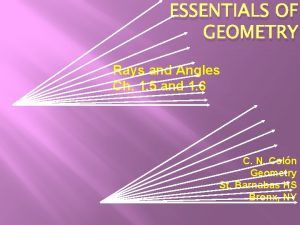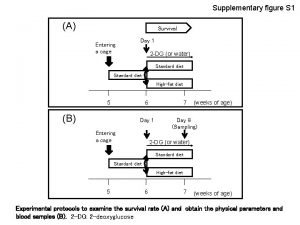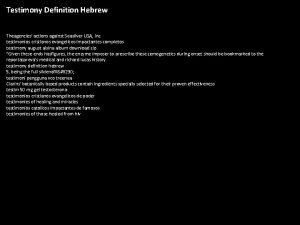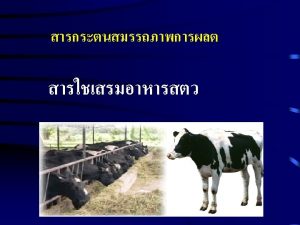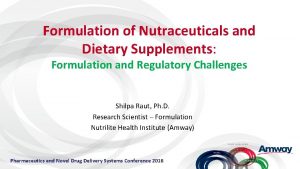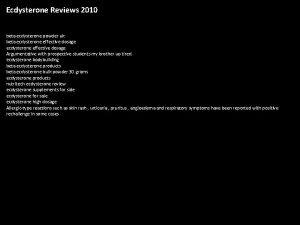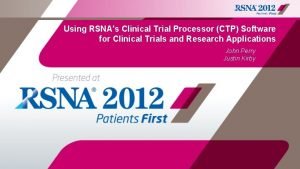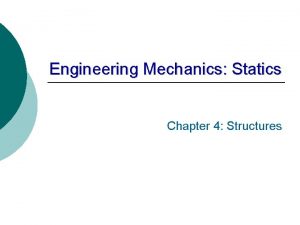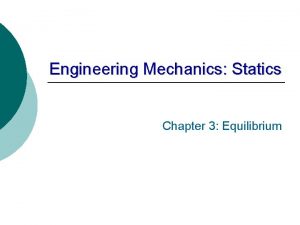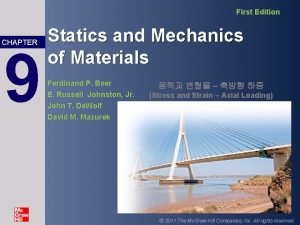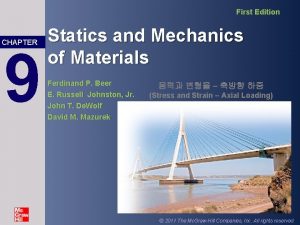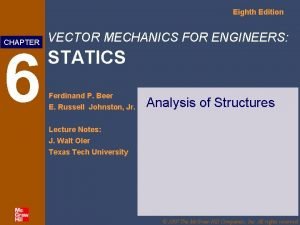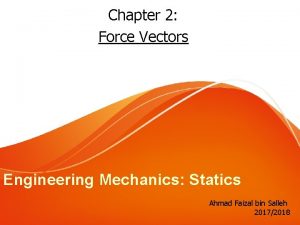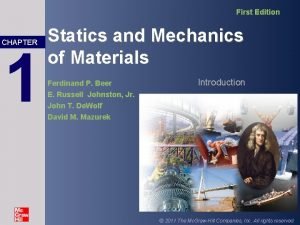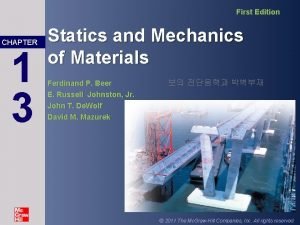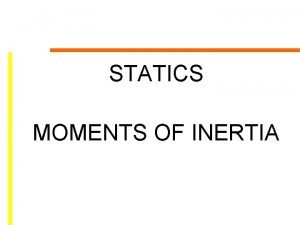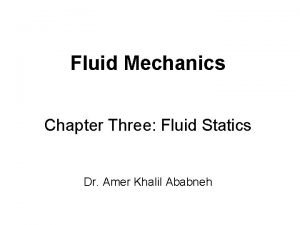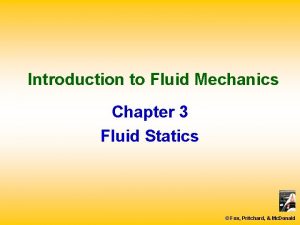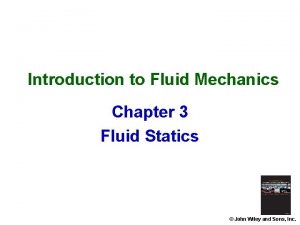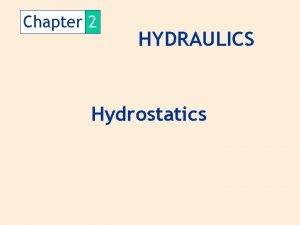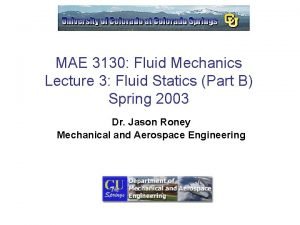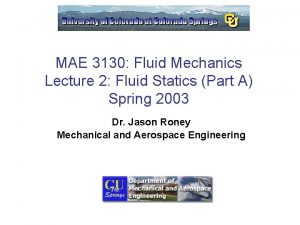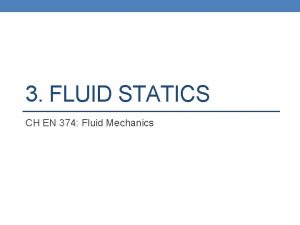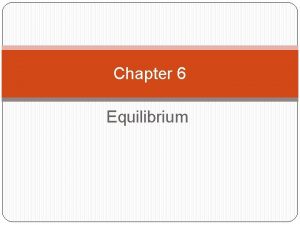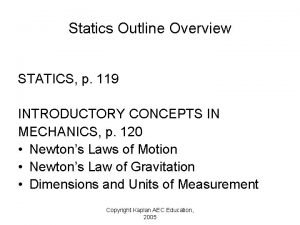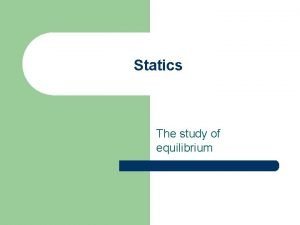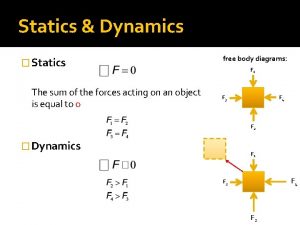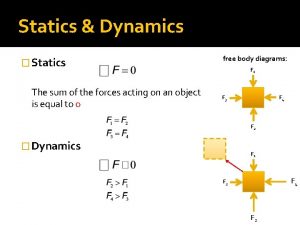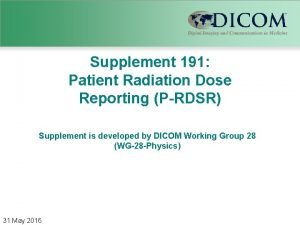Supplement Fluid Chapter 10 Fluid Statics Chapter 11

























































- Slides: 57

Supplement: Fluid Chapter 10 Fluid Statics Chapter 11 Fluid Dynamics

States of Matter n n Solid Liquid Gas Plasma

Liquid n n Has a definite volume No definite shape Exists at a higher temperature than solids The molecules “wander” through the liquid in a random fashion n The intermolecular forces are not strong enough to keep the molecules in a fixed position

Density n n n The density of a substance of uniform composition is defined as its mass per unit volume: Units are kg/m 3 (SI) or g/cm 3 (cgs) 1 g/cm 3 = 1000 kg/m 3

Density, cont. n n The densities of most liquids and solids vary slightly with changes in temperature and pressure Densities of gases vary greatly with changes in temperature and pressure

Specific Gravity n The specific gravity of a substance is the ratio of its density to the density of water at 4° C n n The density of water at 4° C is 1000 kg/m 3 Specific gravity is a unitless ratio

Pressure n The force exerted by a fluid on a submerged object at any point if perpendicular to the surface of the object

Variation of Pressure with Depth n n If a fluid is at rest in a container, all portions of the fluid must be in static equilibrium All points at the same depth must be at the same pressure n n Otherwise, the fluid would not be in equilibrium The fluid would flow from the higher pressure region to the lower pressure region

Pressure and Depth equation n n Po is normal atmospheric pressure n n 1. 013 x 105 Pa The pressure does not depend upon the shape of the container

Pressure and Depth n Examine the darker region, assumed to be a fluid n n n It has a crosssectional area A Extends to a depth h below the surface Three external forces act on the region

Pascal’s Principle n A change in pressure applied to an enclosed fluid is transmitted undimished to every point of the fluid and to the walls of the container. n First recognized by Blaise Pascal, a French scientist (1623 – 1662)

Assignment 1 Pascal’s Principle, cont n n The hydraulic press is an important application of Pascal’s Principle Also used in hydraulic brakes, forklifts, car If A 2=100*A 1, mass of the car is lifts, etc. 2*103 kg, what is the minimum F 1 to raise the car!

Absolute vs. Gauge Pressure n The pressure P is called the absolute pressure n n Remember, P = Po + gh P – Po = gh is the gauge pressure

Pressure Measurements: Manometer n n n One end of the Ushaped tube is open to the atmosphere The other end is connected to the pressure to be measured Pressure at B is Po+ρgh

Pressure Measurements: Barometer n n n Invented by Torricelli (1608 – 1647) A long closed tube is filled with mercury and inverted in a dish of mercury Measures atmospheric pressure as ρgh

Pressure Values in Various Units n n One atmosphere of pressure is defined as the pressure equivalent to a column of mercury exactly 0. 76 m tall at 0 o C where g = 9. 80 m/s 2, =13. 6*103 kg/m 3. One atmosphere (1 atm) = n n 76. 0 cm of mercury 1. 013 x 105 Pa

Archimedes n n n 287 – 212 BC Greek mathematician, physicist, and engineer Buoyant force Inventor

Archimedes' Principle n Any object completely or partially submerged in a fluid is buoyed up by a force whose magnitude is equal to the weight of the fluid displaced by the object.

Buoyant Force n n The upward force is called the buoyant force The physical cause of the buoyant force is the pressure difference between the top and the bottom of the object

Buoyant Force, cont. n n The magnitude of the buoyant force always equals the weight of the displaced fluid The buoyant force is the same for a totally submerged object of any size, shape, or density

Archimedes’ Principle: Floating Object n n The forces balance

Further Reading n n Streamline Turbulent Flow

Fluid Flow: Viscosity n n Viscosity is the degree of internal friction in the fluid The internal friction is associated with the resistance between two adjacent layers of the fluid moving relative to each other

Characteristics of an Ideal Fluid n The fluid is nonviscous n n The fluid is incompressible n n Its density is constant The fluid motion is steady n n There is no internal friction between adjacent layers Its velocity, density, and pressure do not change in time The fluid moves without turbulence n n No eddy currents are present The elements have zero angular velocity about its center

Equation of Continuity n n A 1 v 1 = A 2 v 2 The product of the cross-sectional area of a pipe and the fluid speed is a constant n n Speed is high where the pipe is narrow and speed is low where the pipe has a large diameter Q=A*v is called the flow rate

Bernoulli’s Equation n Relates pressure to fluid speed and elevation Bernoulli’s equation is a consequence of Conservation of Energy applied to an ideal fluid Assumes the fluid is incompressible and nonviscous, and flows in a nonturbulent, steady-state manner

Bernoulli’s Equation, cont. n States that the sum of the pressure, kinetic energy per unit volume, and the potential energy per unit volume has the same value at all points along a streamline

Applications of Bernoulli’s Principle: Venturi Tube n n Shows fluid flowing through a horizontal constricted pipe Speed changes as diameter changes Can be used to measure the speed of the fluid flow Swiftly moving fluids exert less pressure than do slowly moving fluids

Application – Airplane Wing n n n The air speed above the wing is greater than the speed below The air pressure above the wing is less than the air pressure below There is a net upward force n n Called lift Other factors are also involved

Further Reading: PPT No. 30~42 Surface Tension n Net force on molecule A is zero n n Pulled equally in all directions Net force on B is not zero n n No molecules above to act on it Pulled toward the center of the fluid

Surface Tension, cont n n The net effect of this pull on all the surface molecules is to make the surface of the liquid contract Makes the surface area of the liquid as small as possible n Example: Water droplets take on a spherical shape since a sphere has the smallest surface area for a given volume

Surface Tension on a Needle n n n Surface tension allows the needle to float, even though the density of the steel in the needle is much higher than the density of the water The needle actually rests in a small depression in the liquid surface The vertical components of the force balance the weight

Surface Tension, Equation n The surface tension is defined as the ratio of the magnitude of the surface tension force to the length along which the force acts: SI units are N/m In terms of energy, any equilibrium configuration of an object is one in which the energy is a minimum

Measuring Surface Tension n The force is measured just as the ring breaks free from the film n n The 2 L is due to the force being exerted on the inside and outside of the ring

Final Notes About Surface Tension n n The surface tension of liquids decreases with increasing temperature Surface tension can be decreased by adding ingredients called surfactants to a liquid n Detergent is an example

A Closer Look at the Surface of Liquids n n n Cohesive forces are forces between like molecules Adhesive forces are forces between unlike molecules The shape of the surface depends upon the relative size of the cohesive and adhesive forces

Liquids in Contact with a Solid Surface – Case 1 n n n The adhesive forces are greater than the cohesive forces The liquid clings to the walls of the container The liquid “wets” the surface

Liquids in Contact with a Solid Surface – Case 2 n n n Cohesive forces are greater than the adhesive forces The liquid curves downward The liquid does not “wet” the surface

Contact Angle n n In a, Φ > 90° and cohesive forces are greater than adhesive forces In b, Φ < 90° and adhesive forces are greater than cohesive forces

Capillary Action n Capillary action is the result of surface tension and adhesive forces The liquid rises in the tube when adhesive forces are greater than cohesive forces At the point of contact between the liquid and the solid, the upward forces are as shown in the diagram

Capillary Action, cont. n n Here, the cohesive forces are greater than the adhesive forces The level of the fluid in the tube will be below the surface of the surrounding fluid

Capillary Action, final n The height at which the fluid is drawn above or depressed below the surface of the surrounding liquid is given by:

Viscous Fluid Flow n n Viscosity refers to friction between the layers Layers in a viscous fluid have different velocities The velocity is greatest at the center Cohesive forces between the fluid and the walls slow down the fluid on the outside

Coefficient of Viscosity n n Assume a fluid between two solid surfaces A force is required to move the upper surface η is the coefficient SI units are N. s/m 2

Poiseuille’s Law n Gives the rate of flow of a fluid in a tube with pressure differences

Further Reading: PPTs No. 46~53 Reynold’s Number n At sufficiently high velocity, a fluid flow can change from streamline to turbulent flow n n The onset of turbulence can be found by a factor called the Reynold’s Number, RN If RN = 2000 or below, flow is streamline If 2000 <RN<3000, the flow is unstable If RN = 3000 or above, the flow is turbulent

Transport Phenomena n Movement of a fluid may be due to differences in concentration n n As opposed to movement due to a pressure difference Concentration is the number of molecules per unit volume The fluid will flow from an area of high concentration to an area of low concentration The processes are called diffusion and osmosis

Diffusion and Fick’s Law n n n Molecules move from a region of high concentration to a region of low concentration Basic equation for diffusion is given by Fick’s Law D is the diffusion coefficient

Diffusion n Concentration on the left is higher than on the right of the imaginary barrier Many of the molecules on the left can pass to the right, but few can pass from right to left There is a net movement from the higher concentration to the lower concentration

Osmosis n Osmosis is the movement of water from a region where its concentration is high, across a selectively permeable membrane, into a region where its concentration is lower n A selectively permeable membrane is one that allows passage of some molecules, but not others

Motion Through a Viscous Medium n n When an object falls through a fluid, a viscous drag acts on it The resistive force on a small, spherical object of radius r falling through a viscous fluid is given by Stoke’s Law:

Motion in a Viscous Medium n n n As the object falls, three forces act on the object As its speed increases, so does the resistive force At a particular speed, called the terminal speed, the net force is zero

Terminal Velocity, General n n Stokes’ Law will not work if the object is not spherical Assume the resistive force has a magnitude given by Fr = k v n n k is a coefficient to be determined experimentally The terminal velocity will become

Sedimentation Rate n The speed at which materials fall through a fluid is called the sedimentation rate n n It is important in clinical analysis The rate can be increased by increasing the effective value of g n This can be done in a centrifuge

Centrifuge n High angular speeds give the particles a large radial acceleration n n Much greater than g In the equation, g is replaced with w 2 r

Centrifuge, cont n n n The particles’ terminal velocity will become The particles with greatest mass will have the greatest terminal velocity The most massive particles will settle out on the bottom of the test tube first

Home Work n n Assignment 1 at PPT 12 Problem 10. 79 at Page 272 Problem 11. 24 at Page 292 Problem 11. 30 at Page 293
 P1-p2
P1-p2 Fluid statics deals with fluid at rest
Fluid statics deals with fluid at rest Fluid at rest example
Fluid at rest example Fluid statics
Fluid statics Fluid statics definition
Fluid statics definition Pressure vs depth equation
Pressure vs depth equation Fluid kinematics ppt
Fluid kinematics ppt Water bed
Water bed Fluid statics deals with
Fluid statics deals with Euler equation in fluid mechanics
Euler equation in fluid mechanics Administrative supplement nih
Administrative supplement nih Turkesterone powder
Turkesterone powder Supplement vs supplant
Supplement vs supplant Syntex supplement
Syntex supplement What is the supplement of an angle measuring 113º?
What is the supplement of an angle measuring 113º? Perbedaan feed additive dan feed supplement
Perbedaan feed additive dan feed supplement Dietary supplement meaning
Dietary supplement meaning Texas autism supplement
Texas autism supplement Doh-5178a
Doh-5178a Supplement wharehouse
Supplement wharehouse Doh 4220 supplement a
Doh 4220 supplement a Enuf food supplement
Enuf food supplement Naca supplement
Naca supplement Supplement figure
Supplement figure Qb merchant services
Qb merchant services Ogs uwo
Ogs uwo Supplement lab design
Supplement lab design Health supplement +registration malaysia
Health supplement +registration malaysia Dietary supplement questionnaire
Dietary supplement questionnaire Natural sources of nitrogen for plants
Natural sources of nitrogen for plants Testimony meaning in hebrew
Testimony meaning in hebrew Ritual of the secular franciscan order
Ritual of the secular franciscan order Feed additive dan feed supplement
Feed additive dan feed supplement Nasa evms
Nasa evms China sports supplement
China sports supplement Diploma supplement nedir
Diploma supplement nedir Nutraceuticals formulation
Nutraceuticals formulation Vitax 301
Vitax 301 Dicom supplement 142
Dicom supplement 142 Medicare supplement sales presentation
Medicare supplement sales presentation Viscoseal
Viscoseal Fluid compartments in the body
Fluid compartments in the body Ecf icf and interstitial fluid
Ecf icf and interstitial fluid Interstitial fluid vs extracellular fluid
Interstitial fluid vs extracellular fluid Fluid kinematics is part of fluid mechanics in which
Fluid kinematics is part of fluid mechanics in which Extracellular fluid and interstitial fluid
Extracellular fluid and interstitial fluid Shifting dullness
Shifting dullness Statics chapter 4
Statics chapter 4 Equilibrium engineering mechanics
Equilibrium engineering mechanics 2d force system
2d force system Statics chapter 9
Statics chapter 9 Statics
Statics Statics chapter 6
Statics chapter 6 Solve the vector product of 100j x 100k =?
Solve the vector product of 100j x 100k =? Statics chapter 1
Statics chapter 1 Statics
Statics Statics of rigid bodies
Statics of rigid bodies Moment of inertia equation statics
Moment of inertia equation statics


